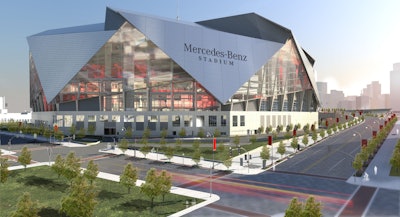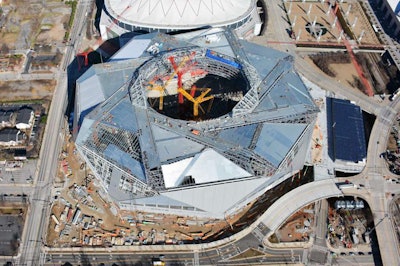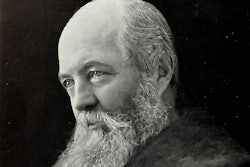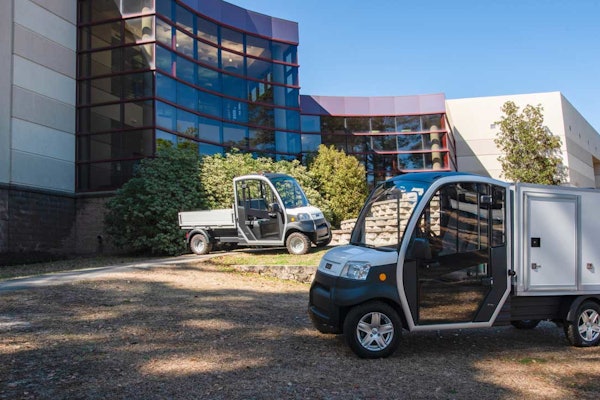 Mercedes-Benz Stadium will be able to charge 48 electric cars simultaneously.
Mercedes-Benz Stadium will be able to charge 48 electric cars simultaneously.Photo: Mercedes-Benz Stadium
The Sacramento Kings’ Golden 1 Center may have finished in time to be the world’s first LEED Platinum certified indoor sports venue, but the Mercedes-Benz Stadium will still be the first NFL and MLS stadium to earn the highest certification level.
“We’re setting a new standard for sustainable building in sports, which positions us well to reduce our carbon footprint,” said Scott Jenkins, general manager of Mercedes-Benz Stadium and chairman of the Green Sports Alliance. “This was the more expensive route in building the stadium, but it’s the right way to do business.”
Waste Management estimates that the NFL, MLB, NBA and NHL combine to generate 35,000 metric tons of CO2 each year from their fans’ waste.
Mercedes-Benz Stadium is a multi-purpose retractable roof stadium that will replace the Georgia Dome and become the new home for the Atlanta Falcons and the new major league soccer team, Atlanta United FC.
Arthur Blank, owner of the Falcons, expressed interest in a new stadium back in 2010 but it wasn’t until 2014 that construction began. He originally wanted to set an example for others by having the stadium be sustainable and at least LEED Gold certified.
At first it seemed this wasn’t feasible, but soon after Jenkins was hired as general manager of Mercedes-Benz Stadium Blank raised the bar to LEED Platinum certification.
 Construction is planned to be completed July 30, 2017.
Construction is planned to be completed July 30, 2017.Photo: Mercedes-Benz Stadium
To reach this level of certification, the stadium had to earn 80 or more credits. It will be the first stadium to earn every water credit available. The design includes a 1,100,000-gallon storm vault and a 680,000-gallon cistern to collect water. This recaptured rain water will be used for landscape irrigation and the cooling towers.
“It will additionally help do our part to alleviate flooding in the surrounding communities that are part of the Proctor Creek Watershed,” Jenkins said. “Given the history of flooding in the neighboring area, it’s extremely important we reached that goal.”
Another way Mercedes-Benz Stadium focused on earning credits was through the Materials & Resources category. This category is designed to consider the entire life cycle of the building and rewards project teams for buying less material.
“This category is entirely different from previous versions of LEED and has been pursued by very few projects,” Jenkins said. “Through an innovative approach, working directly with project manufacturers, we are breaking new ground not only in the sports industry but also in the building industry with our pursuit of this v4 credit strategy.”
The stadium will use 29 percent less energy than a traditional sports venue, thanks to the 4,000 solar panels that will produce around 1.6 million kilowatt hours. In game time terms, it is enough energy to power nine Falcons home games or 13 Atlanta United home games.
Around the stadium is 110,639 square feet of space saved for landscaping and an additional 14-acre green space is included in the design, which will be used for a variety of community events.
Edible landscaping, including blueberries and apples, will be incorporated and it will be used to benefit the local community.
Inside the stadium, it was decided that artificial turf would be used for the field.
“We made a decision back in 2013 because we knew that the field wouldn’t get enough sun light to grow the grass,” Jenkins said. “The multi-purpose nature of the building complicated the idea of natural grass as well. The turf will stay down at all times and a hard floor will be put on top of it, when it comes time to switch. We also reviewed a variety of surfaces to ensure that the turf was going to be the best possible surface for both our football and soccer.”
The roof of the stadium can close when needed based on weather conditions, but the stadium has been weatherized so football and soccer games can still be played in the open configuration even if it is raining.
“Our roof is one of the marquee design elements of our stadium,” he said. “Inspired by the oculus in the ancient Roman Pantheon, the eight petal roof opens and closes like the aperture of a camera and is a major shift from the kinetic roofs of past sports facilities. The petals are clad with clear ETFE-fabric so that even in the closed position you have natural light coming through and the sensation of an open-air stadium.”
While the Kings and Falcons seem to be paving the way with sustainability, Jenkins believes that sustainable design is the future for all future sports venues.
“Innovation is an integral part of our society and as the sports industry continually looks for ways to improve – sustainability is a great field to innovate,” he said. “We’re happy to lead the green initiative to inspire future sports venues, however, we want to go beyond that and motivate our Falcons/United Family, the citizens of Atlanta, and people across the world to lead a more healthy and eco-friendly life.”
The Mercedes-Benz Stadium is scheduled to open July 30, 2017, and will host the 2018 College Football Playoff National Championship, 2019 Super Bowl, and 2020 NCAA Men’s Final Four
Check out the video below for more on the stadium:









